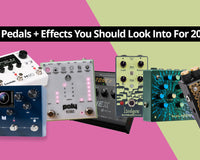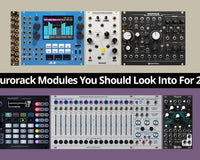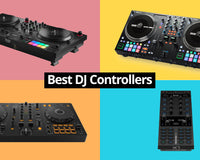The infinite nature of DAWs can be burdensome. With the growing complexity of computer-based setups, some producers are seeking simplicity in their music production workflow.
Sometimes the limitations of working with a single piece of gear can actually give you more freedom, and the resulting focus can lead to more creativity.
Working with something like a groovebox or semi-modular synth gives you knobs, buttons and sliders to interact with, allowing you to escape from the usual mouse-based workflow of a DAW. Now there are powerful multi-FX units that can replace what used to take up valuable space in your studio.
In many ways, less can be more.
Grooveboxes
Grooveboxes are standalone music production tools featuring everything you need to produce a full track. This includes sound engines, samplers, a multitrack sequencer, and a mixer to help you create something at the same quality as a DAW allows.
Grooveboxes have a unique workflow that is different from working inside a DAW on a computer - a workflow that may be better suited for some producers. The portability and button/knob form factor allow you to escape the typical mouse-based control and give you a very hands-on approach to making music.
Grooveboxes require nothing but a pair of headphones or speakers to create music, keeping your set up extremely minimalistic. Each groovebox will come with built-in sounds and synth engines. Sampler-based grooveboxes will allow you to record incoming audio which you can cut up and trigger with the pads.
The AKAI MPC ONE boasts a small footprint while still featuring everything you need to program beats, edit audio and mix FX. The MPC ONE includes all the expected functionality of a classic MPC groovebox with an added modern touch.
A 7-inch multi-touch display helps you navigate its deep set of functionality, and 16 velocity-sensitive pads are there to dynamically trigger sounds. It is fairly advanced, with onboard software that is similar to a DAW. It also can be plugged into your computer to be triggered by your DAW or act as a MIDI controller.
The ELEKTRON DIGITAKT is another small groovebox. Elektron takes a different approach to sequencing compared to the Akai. It has a simplified display to focus on a more sound-based route to create music - a route that may be more desirable to those escaping their typical DAW workflow. Elektron devices are known for their Trig Conditions and Parameter Locks, a creative function for creating organic grooves with tonal variety.
 Though officially called a “Drum Computer,” the Digitakt is capable of playing melodic material, with 8 voice layers ready for sequencing. If you are looking to expand beyond a single piece of gear, the Digitakt has 8 additional MIDI tracks ready to sequence your other hardware or control instruments inside your DAW.
Though officially called a “Drum Computer,” the Digitakt is capable of playing melodic material, with 8 voice layers ready for sequencing. If you are looking to expand beyond a single piece of gear, the Digitakt has 8 additional MIDI tracks ready to sequence your other hardware or control instruments inside your DAW.
These MIDI channels each have an LFO that can be a great way to add life to a guitar pedal or other piece of gear with MIDI connectivity that would not be possible otherwise.
For something extremely minimal, there are the TEENAGE ENGINEERING POCKET OPERATORS. These tiny calculator-like units pack a punch despite their small form. Coming in many different models, and at just over $100 each, the Pocket Operator is the perfect way to create music on the go.
 The PO-33 KO is a sampler with a built-in microphone for sampling the world around you. PO-35 Speak is a vocal synthesizer with a unique sound engine. Some Pocket Operators have built-in microphones for sampling, others have extra FX features. All of them have a 16-step sequencer and memory for 16 patterns.
The PO-33 KO is a sampler with a built-in microphone for sampling the world around you. PO-35 Speak is a vocal synthesizer with a unique sound engine. Some Pocket Operators have built-in microphones for sampling, others have extra FX features. All of them have a 16-step sequencer and memory for 16 patterns.
The Pocket Operators are able to sync with each other - perfect for jamming with friends. The minimalist design makes these a great introductory device for someone who has never used a groovebox. They are battery powered and have built-in speakers so you can take them anywhere and create music.
If you ever do want to work with both a groovebox and your DAW, they are syncable via MIDI and most come with software that allows you to capture multi-track audio from the groovebox into your DAW.
Semi-modular systems
Another way to create with minimal gear is with a semi-modular synthesizer. These synths come prewired to make sounds instantly with the press of a key, but have the added functionality of CV patch points to build complex modular mayhem.
Some semi-modulars feature a traditional or mini keyboard for playing notes while others have alternative ways of receiving pitch data. The CV jacks allow you to interact with other modular gear and the MIDI functionality gives you the option of working with your DAW or a MIDI controller.
Semi-modular synths are a perfect system to explore and learn synthesis while also being ready to make a huge sound out of the box. The limitations of working within a standalone synth system allow you to dig deep into each section of the synth and discover its capabilities.
The MOOG MUSIC MATRIARCH is a 4-voice paraphonic synthesizer. Each oscillator voice can be sequenced separately but they all share a single multi-function filter. Each section of the synth has multiple CV jacks for exploratory patching. Everything is laid out like a traditional modular synth system to visually divide each section of the synth and bring some order to your (hopefully) chaotic patching.
Beyond the usual features of a subtractive synthesis system, the Matriarch has an additional LFO, two mults, and three voltage controlled attenuators for enhancing and sculpting your sound design. There is a sequencer/arpeggiator built-in and a lush stereo delay to bring your sound to the next level.
 The ARTURIA MINIBRUTE 2 is a similar subtractive synth system but uses a patch matrix approach. The Minibrute has 2 oscillators and one multi-mode filter, with all the CV patch points located in a grid on the right side of the synthesizer.
The ARTURIA MINIBRUTE 2 is a similar subtractive synth system but uses a patch matrix approach. The Minibrute has 2 oscillators and one multi-mode filter, with all the CV patch points located in a grid on the right side of the synthesizer.
The Minibrute’s sequencer/arpeggiator is based on their KeyStep MIDI controller and allows an intuitive way to improvise while staying synced to a clock. The Minibrute is a perfect companion for the ARTURIA DRUMBRUTE or ARTURIA RACKBRUTE 3U if you are ever looking to expand your system while still keeping things minimalistic.
 Getting more experimental than these traditional systems, we have the MAKE NOISE STREGA. This semi-modular synth was designed in collaboration with Alessandro Cotrini, inspired by his music and sonic experimentations. The Strega abandons the typical labels and instead features knobs for things like “absorb”, “activation”, and “tonic”.
Getting more experimental than these traditional systems, we have the MAKE NOISE STREGA. This semi-modular synth was designed in collaboration with Alessandro Cotrini, inspired by his music and sonic experimentations. The Strega abandons the typical labels and instead features knobs for things like “absorb”, “activation”, and “tonic”.
The Strega is set up to make sound without any inputs and has touch plates for direct interaction with the synth. It has patch points for connecting with other modules, notably the MAKE NOISE 0-COAST and MAKE NOISE 0-CTRL which are the same size and allow for MIDI connectivity.
The Strega also has audio inputs and can serve as a powerful FX unit, sculpting or mangling the sounds to send into it. This synth is definitely aimed at someone seeking non-traditional sound design and will produce endless, unique tones for those who decide to explore its capabilities.
Powerful eurorack modules
For those more accustomed to eurorack workflow, or those looking for a feature-rich module to start their collection, there ways to create diverse sounds with just one module.
In a minimalistic modular system, a multimode oscillator can save a lot of space. The MUTABLE INSTRUMENTS PLAITS has 16 different voice types built into it. Ranging from common sounds like FM synthesis to kick drums and snare drums, and even the modal and karplus-strong algorithms from their RINGS module.
Plaits has CV input for choosing the voice model allowing you switch between voices in a single sequence. This can be great for programming a kick/snare/hi-hat groove with just one sound source, or vastly diversifying the timbre of a lead melody as it progresses.
 If you like distortion, the Noise Engineering team packed their RUINA VERSIO with as many types of distortion as they could. With a wavefolder, multiband distortion, notch filter, and even a DOOM parameter, this unit can mangle your audio in many different ways.
If you like distortion, the Noise Engineering team packed their RUINA VERSIO with as many types of distortion as they could. With a wavefolder, multiband distortion, notch filter, and even a DOOM parameter, this unit can mangle your audio in many different ways.
The Ruina Versio runs on their Versio stereo DSP platform which allows you to install different firmware including their NOISE ENGINEERING IMITOR VERSIO delay and NOISE ENGINEERING DESMODUS VERSIO reverb. The module is offered with an alternative simplified faceplate if you plan on switching the firmware often and don’t want the parameter labels to mismatch their function.
Multi-effect guitar pedals
Outside of grooveboxes and eurorack, there are many multi-effect guitar pedals that provide a vast array of possibilities in one box. Multi-effect pedals are nothing new, but the technology has evolved to a point where this may be a better suited option versus assembling a pedal board.
All-in-ones like the BOSS GT-1000CORE brings the functionality of the BOSS DD-500, RV-500, and MD-500 pedals into one piece of hardware. The GT-1000 allows you to engineer entire effect chains and store them as easy-to-access presets within the pedal. It includes typical guitar pedal modules like distortion, reverb, and delay, while also integrating dynamics, preamps, and amp cab simulation.
With the FX send loop, you can integrate your existing pedals into any part of the chain for extreme flexibility. The GT-1000 also has assignable switches and knobs to control any of the virtual FX in the patch, and can connect to the BOSS Tone Studio mobile app for easy editing.
For something a little less robust and more effect-specific, there are plenty of pedals that allow you to explore one effect or a few effects more deeply.
 The HOLOGRAM ELECTRONICS INFINITE JETS is a resynthesizer pedal that reinterprets the dynamics, notes, and chords you play into new sounds. There are 10 effects in four categories: Blur, Swell, Glitch, and Synth.
The HOLOGRAM ELECTRONICS INFINITE JETS is a resynthesizer pedal that reinterprets the dynamics, notes, and chords you play into new sounds. There are 10 effects in four categories: Blur, Swell, Glitch, and Synth.
Each setting adds instant flare to your playing and can be used to create ambient textures that fade into one another. The internal LFO and envelope generators help add movement to the effects, and a drive knob can saturate the signal with analog saturation.
 To go beyond the constraints of a typical pedal or multi-fx unit, there is the EMPRESS EFFECTS ZOIA. ZOIA, at its core, is a modular synthesizer in the form of a pedal. It comes preloaded with 80+ modules that you can chain together to create infinite possibilities of sound.
To go beyond the constraints of a typical pedal or multi-fx unit, there is the EMPRESS EFFECTS ZOIA. ZOIA, at its core, is a modular synthesizer in the form of a pedal. It comes preloaded with 80+ modules that you can chain together to create infinite possibilities of sound.
ZOIA includes the usual effects found in a guitar multi-fx pedal but adds modular synth controllers like LFOs, oscillators, filters, and envelope generators. ZOIA has room for 64 patches for recall during performance, and they can be shared online on the ZOIA online community patchstorage.com.
The Takeaway
We live in a fast-moving world of music production, and there is always pressure to gain skills with as many different tools as possible. Nevertheless, lately there is more and more evidence that deeper knowledge is better than broad knowledge, and this is applicable to your music production.
Taking your time to work with fewer tools, and learning these tools with more depth can prove to be extremely beneficial to your skillset and help you stand out as a craftsperson.
You will be saving both space and time - your studio will be less cluttered, and you will spend less time tinkering with new things. You will become faster at achieving the sound you want, leaving more room for further development and new projects.
Did I miss anything? What is your favourite minimalist gear that produces maximum sound?









